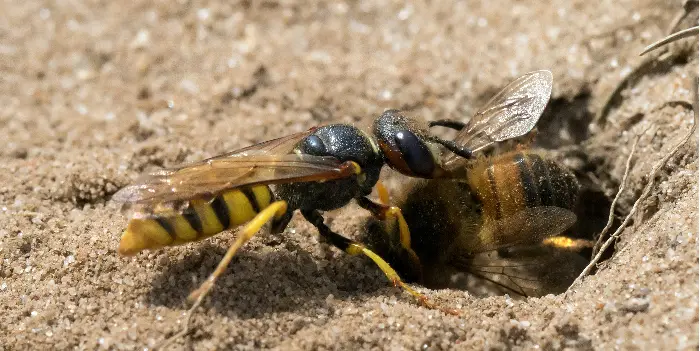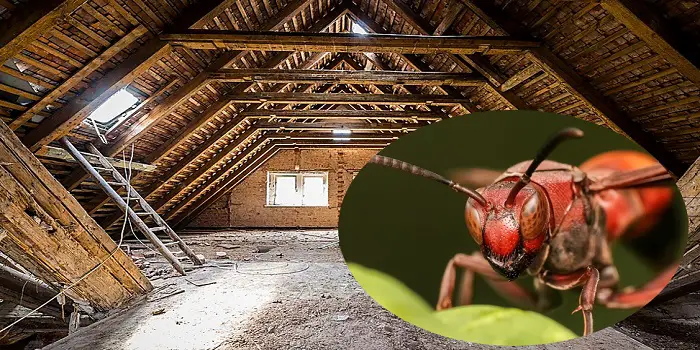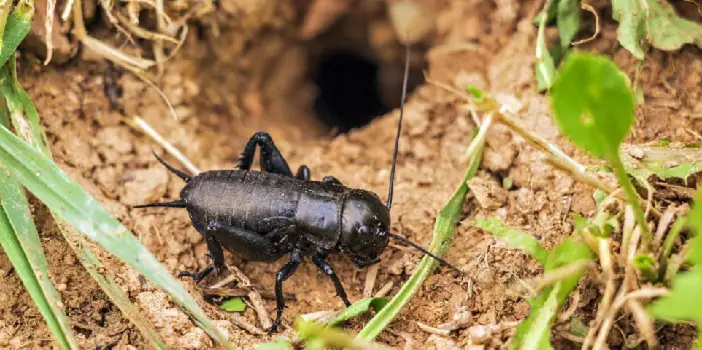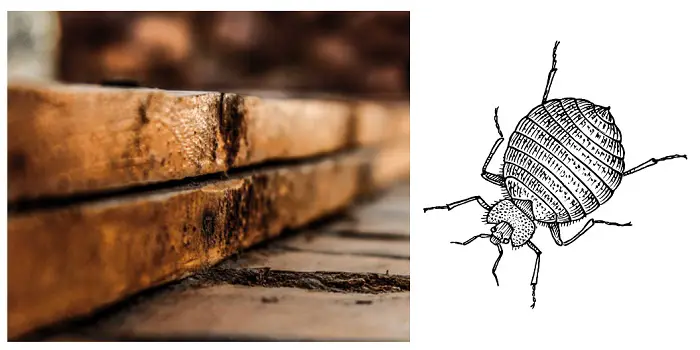
Because bed bugs are parasites, they are more challenging to get rid of than most insects.
Plus, they are quite adept at living in your clothes, bedding, carpet, and even small holes in the flooring and walls.
Since they can be found in wood, many people wonder if they can eat or chew through that hard substance.
The short answer is no; bed bugs cannot either eat or chew through wood. Even if they wanted to, bed bugs lack the jaws necessary to do the chewing.
That is because, much like mosquitoes, bed buds feast only on blood and have a long straw-like mouth for extracting it from under the skin.
What this means is that your firewood and the wooden structure of your home are not vulnerable to bed bugs.
Are Bed Bugs Attracted to Wood?
Bed bugs are not attracted to the wood in the sense of being a source of food.
But as shelter, they can seek out the tiny holes and cracks found in the walls and flooring of your home.
However, bed bugs will seek out any hiding place, no matter the material, if they can find protection.
So, in the strictest sense, bed bugs are not attracted to wood any more than they are attracted to fabric, metal, or other substances.
They only seek out hiding places during the day for protection. Once darkness comes, they leave their protected places to find food.
Do They Lay Eggs in Wood?
Not on the surface, but they will lay their eggs in the tiny holes and cracks in the wood if there is no better place for the nest.
The substance itself is not that important to bed bugs.
Only that they have a protected place to lay their eggs.
So, the tiny holes and cracks in the wood are just as good a place as any for them to create a nest.
Can They Burrow into Wood?
Despite being found in the tiny holes and cracks in the wood, bed bugs lack the jaws to do any burrowing.
Even if they wanted to, they lacked the physical equipment necessary to make a dent in the wood.
All they can do is take advantage of the holes and cracks.
So, you do not have to worry about bed bugs burrowing into the wooden surfaces of your home or the furniture.
Having said that, you may be surprised at just how many holes, and cracks are in the wooden features of your home.
Chances are, if you see bugs infesting the wooden spaces of your home, they are most likely termites, ants, or perhaps a type of beetle.
This is because bed bugs themselves are so small that they are quite difficult to see.
Can Bed Bugs Live on the Wood Floor and Furniture?
Yes, they can live in tiny spaces, such as the cracks and holes found in the surface of the wood floor or furniture.
This means that any opening large enough to hold a nest for bed bugs is enough to make it their home.
But having said that, bed bugs are probably more likely to choose the bedding of your mattress compared to the wood of the walls, floor, cedar siding, or furniture of your home.
This is because bed bugs prefer to be near you and those who live in your home.
This means that an initial invasion of bed bugs will concentrate on your mattress.
Once they grow in numbers, they will spread out to the surrounding walls, couch, tables, chairs, and flooring of your bedroom.
In other words, if you discover bed bugs on the floor or walls, chances are the infestation has grown quite large.
Can bed bugs live on parquet floors?
If you live in a home with parquet floors, mainly if they have aged, then that is a prime area for bed bugs to reside.
When wood deteriorates, it can create many openings for bed bugs to hide and lay eggs to create more bed bugs.
However, even with the close availability of parquet flooring, bed bugs will first choose the mattress or bedding to call home.
Even the furniture is not high on their list even when made of wood.
For example, a chair or couch with cushions usually means that if bed bugs are present, they are most likely in the cushions and not the wooden structure.
Cushions or mattress material is not only desirable because of the environment but also because of the proximity to their food source.
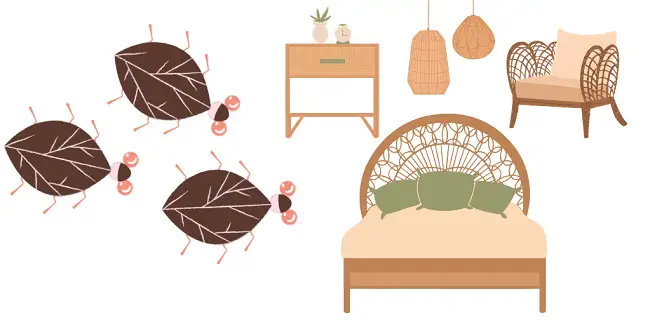
Different Ways to Getting Rid of Bed Bugs From Furniture
If you find that bed bugs have invaded your home, then there are few proven methods for getting rid of them.
What follows is each method for removing bed bugs from the wood furniture in your home.
1 – Pesticides
Start by using your vacuum cleaner to suck up the bed bugs that may be in the wooden flooring.
Next, use a steamer that generates enough heat to kill the remaining bed bugs on contact.
This should rid most of your wooden surfaces of bed bugs.
However, you will need to add a pesticide to ensure that all of the bed bugs are destroyed.
Remove all furniture, mattresses, carpets, and bedding from home.
Then, fumigate by spraying the pesticide or specialized bed bug treatment sprays (like Green Bean Buddy) into the flooring.
Now, spray all the wooden furniture with the pesticide and wash the bedding, mattresses, and carpeting.
Wait for the pesticides to dry up, and then you can bring back in the treated furniture, mattresses, and carpeting.
2 – Use Floor Barriers
In other words, fill all the cracks in the flooring using wood putty after applying pesticides to kill the bed bugs.
The goal is to destroy any bed bugs that might be living in your home’s flooring.
Simply spray the area with pesticides, especially the holes and cracks in the flooring, let the pesticide dry, and then fill any holes or cracks with wood putty.
3 – Interceptors
A bed bug interceptor is a plastic cup or dish that is big enough to set under your bedpost.
This is a safe, passive form of protection that keeps bed bugs from reaching your mattress.
You’ll want to place the bed bug interceptor device around each foot of the bed on the floor.
The interceptor, which can be purchased in stores, can be used as-is or filled with water to drown the bed bugs.
Set up the interceptor traps and wait for a day to see if they have caught any bed bugs.
If so, you can pitch the interceptors in the trash and then move to treat your home.
4 – Heat Treatment
Heat treatment is safer compared to pesticides, especially on your wood flooring.
This means that the bed bugs are eliminated with no residue that might be harmful to you or your pets.
Although there are specific DIY steps and tools for this method, calling a qualified exterminator and letting them do the job is recommended.
They can use the best tools to apply the exact heat, destroying the bed bugs without damaging your wood furniture.
While they do cost more money compared to the other treatments mentioned, they will rid your home of bed bugs relatively quickly
5 – Use Caulk
Although not much talked about, using caulk to remove bed bugs from wood furniture and floors is a great idea.
Bed bugs are crafty in the sense that they will find many wood places to hide and lay their eggs when they are not seeking out sources of food.
Plus, given the sheer number of entrances, it can be difficult to plug them all up.
But if you can do it, the bed bugs would be denied an easy place to hide and nest, which would considerably reduce their numbers.
Caulk will help to simply fill up and seal the cracks and joints that serve as hiding spots for bed bugs.
To get better results, treat the areas then and adequately use caulk.
6 – Essential Oils and Alcohol
Alcohol and certain essential oils can kill bed bugs if they get in contact with them.
But the tricky part is every bug should be identified and sprayed carefully using rubbing alcohol or essential oils.
If you leave even a single bug in an infestation, they can multiply fast and create problems in a few weeks.
Few essential oils that can work as a preventative measure for repelling the hiding bed bugs from your home include:
- Lavender
- Thyme
- Oregano
- Cedar oil
- Tea tree oil
- Peppermint
- Lemongrass
You can dilute the oil in a spray bottle and then spray around the affected areas such as hardwood floors, old furniture, curtains, bed sheets, mattress, etc.
7 – Avoid Buying Secondhand Furniture
I know it’s tempting for many of us due to the huge amount of money it can save, but if you can avoid secondhand furniture, you can easily prevent bed bugs from entering your home.
I would rather say that you should inspect even the new furniture you plan to bring into your home.
Especially if it’s secondhand furniture, it may already have a bug infestation that should be carefully detected and treated.
For example, if it’s an old painted furniture piece with some loose paint, most likely, the bugs will be hiding under the paint layer or on soft, uneven painted surfaces.
What are the Signs of Bed Bugs Infestation?
Although bed bugs are hard to identify, they are not invisible.
If you can carefully inspect (maybe by using a magnifying glass and flashlight), you can detect the infestation caused by the signs they will sometimes leave in your home.
a) Bugs and their eggs
Adult bed bugs are mostly reddish-brown with a flat, oval-shaped body.
While adult bugs can be seen easily, it’s hard to see the nymphs because of their tiny size and translucent appearance.
The eggs of bed bugs are smaller than a rice grain with a milky white color.
Just shine a flashlight into furniture joints, seams, crevices, voids, screw holes, and narrow openings. You will most probably find them here.
b) Dried blood and skin
Dried blood spots on your furniture items or floors can also be a possible sign of bed bug infestation.
These bugs also shed their skin 4-5 times during their life span.
These discarded bed bug exoskeletons are of the size of a live bed bug and can be a good indication of their presence.
c) Bed bug waste
The excrement of the insects will usually look like thin black streaks or dark spots on your furniture.
Since bed bugs will spend most of their time hiding, you can check for these marks on the shelves, headboards, underside of tables, wooden picture frames with backing paper, wallpaper, etc.
If you see these signs, you should know how to clean them away as soon as possible.
How to Clean Feces and Marks of Bed Bugs on Wood?
Once the bed bugs have been removed, the next step is to clean up the feces and marks that have been made on your wooden flooring, walls, and furniture.
Cleaning up the bedding and fabrics can be done in the washing machine at hot temperatures.
But you cannot put your furniture or flooring inside the washing machine.
Using steam can help loosen the marks and feces from the flooring.
- A better solution is to mix hydrogen peroxide with ammonia.
- Simply combine both products and put them in a spray bottle.
- Spray the combination on the wooden surface and wipe it away with a cloth.
Keep it away from any fabrics or your bedding as the hydrogen peroxide can lighten its coloring.
Other Related Questions:
Do bed bugs fly?
No, bed bugs cannot fly because they don’t have wings.
But they are good at crawling and moving around through their six legs, via which they can get into your wood furniture, bed, mattresses, luggage, etc.
Do bed bugs build nests?
Bed bugs do not build nests, but the female ones can lay their eggs in groups almost anywhere.
In addition to bed, mattresses, and upholstery, you will most commonly find them in the cracks, crevices, or holes in wood.
Can bed bugs travel on people?
Unlike lice or ticks, bed bugs prefer not to live on the body of humans once they’ve fed.
The reason is the heat that the human body produces which they can’t resist. Bed bugs prefer to live in cooler areas.
This also means that bed bugs do not transmit any major diseases to people you should be worried about.
However, they can bite, and their bites can be itchy.
If scratched much, it can cause skin infection and irritation especially to those who are allergic.
But worry not, bed bug bites can be treated with an over-the-counter pain reliever such as calamine lotions, anti-itching creams, or an oral antihistamine.
The Conclusion
Bed bugs can be found on wooden surfaces, but they do not bore into or through the material.
Instead, they will find tiny holes and cracks to hide and lay their eggs.
While wooden flooring is not the first choice of bed bugs, they will reside there if necessary.
All a bed bug will need is a crack the width of a credit card to fit into.
Once inside, they can hide and lay their eggs. This means that they can be found in many different places.
By using any one of the methods mentioned, you can rid your home of bed bugs along with the wooden flooring, walls, and furniture.

Welcome to ProShieldPest.com. I am Tina Jones. I have been working as a pest removal professional in Winslow, Arizona lately. At present, I love to spend my time with my family as a retiree.
Here I share all my knowledge and experiences to help people understand better how they can stop pests at their homes without actually killing them. Hopefully, the information you will find here will help in safeguarding your home! You can check more about me here.


